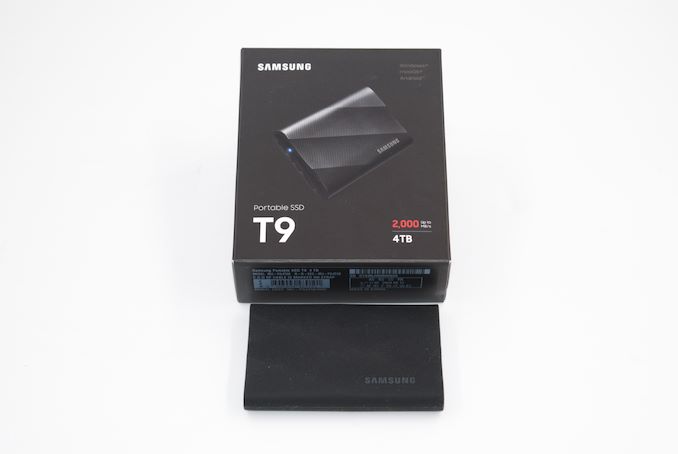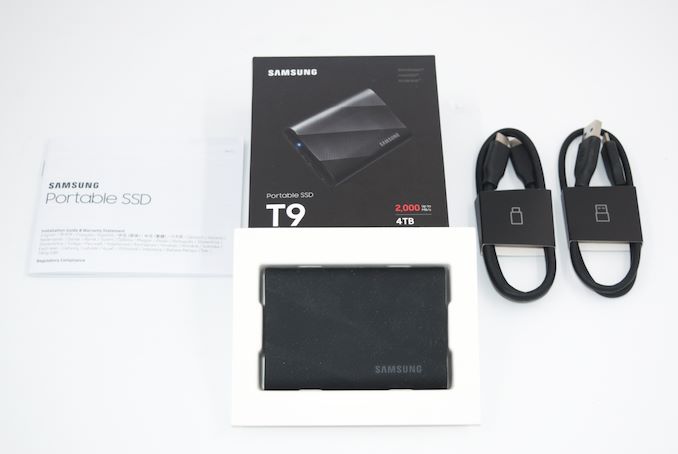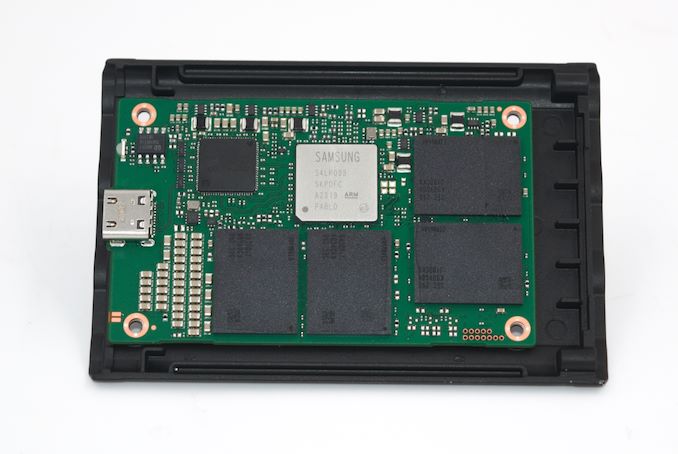Samsung T9 Portable SSD Review: A 20 Gbps PSSD for Prosumer Workloads
by Ganesh T S on October 3, 2023 10:00 AM EST- Posted in
- Storage
- SSDs
- Samsung
- External SSDs
- USB 3.2 Gen 2x2
- Portable SSDs

Samsung's portable SSD lineup has enjoyed significant market success since the launch of the T1 back in 2015. Despite the release of the Thunderbolt-capable X5 PSSD in 2018, the company has been focusing primarily on the mainstream market with its T series drives.
The first set of PSSDs from Samsung incorporated a SATA SSD behind a USB 3.2 Gen 1 bridge chip. With the T5 in 2017, the company moved to a USB 3.2 Gen 2 bridge while retaining the SATA SSD. In the T7 Touch launched in 2020, the SATA component was replaced by a NVMe SSD and the USB 3.2 Gen 2 SATA bridge was replaced by a NVMe one. The T7 series was augmented with IP65-rated models (the T7 Shield) in 2022. Despite the same T7 moniker, the Shield's use of newer NAND enabled improvements in both latency and power consumption.
Samsung is introducing the 2 GBps-class Portable SSD T9 today. Equipped with a USB 3.2 Gen 2x2 (20 Gbps) interface, the PSSD advertises double the performance of the T7 Shield. The company sent over the highest capacity version (4 TB) to put through our rigorous evaluation routine for direct-attached storage devices. The review below presents an in-depth investigation into the design and performance profile of the Samsung Portable SSD T9.
Introduction and Product Impressions
External bus-powered storage devices have grown both in storage capacity as well as speeds over the last decade. Thanks to rapid advancements in flash technology (including the advent of 3D NAND and NVMe) as well as faster host interfaces (such as Thunderbolt and USB 3.x / USB4), we now have palm-sized flash-based storage devices capable of delivering 3GBps+ speeds. While those speeds can be achieved with Thunderbolt, mass-market devices have to rely on USB. Within the USB ecosystem, USB 3.2 Gen 2 (10 Gbps) is fast becoming the entry level for thumb drives and portable SSDs. USB 3.2 Gen 2x2 (20 Gbps) got off to a slow start, but recent computing platforms from both Intel and AMD have started to support it on the host side. The introduction of native USB 3.2 Gen 2x2 flash controllers such as the Phison U18 and Silicon Motion SM2320 has enabled PSSD vendors to bring low-cost power-efficient 20 Gbps external drives to the market.
Broadly speaking, there are five distinct performance levels in this market:
- 2GBps+ drives with Thunderbolt 3 or USB4, using NVMe SSDs
- 2GBps drives with USB 3.2 Gen 2x2, using NVMe SSDs or direct USB flash drive (UFD) controllers
- 1GBps drives with USB 3.2 Gen 2, using NVMe SSDs or direct UFD controllers
- 500MBps drives with USB 3.2 Gen 1 (or, Gen 2, in some cases), using SATA SSDs
- Sub-400MBps drives with USB 3.2 Gen 1, using UFD controllers
Within each of these levels, there is further segmentation into entry-level, mid-range, and premium based on the choice of internal components. The Samsung Portable SSD T9 4 TB we are looking at today belongs to the second category in the above list. The T9 package comes with the main unit, an installation guide, and two 45 cm USB cables. The Type-C to Type-C one supports 20 Gbps speeds, while the Type-C to Type-A is restricted to 10 Gbps speeds. The main unit has a LED indicator and a Type-C female port (USB 3.2 Gen 2x2 is supported only with Type-C ports).
The main unit has a rubber sleeve, providing it with a bit of ruggedness (withstanding drops, etc.). However, the T9 does not have an IP rating. Disassembling the unit is fairly trivial - after removal of the sleeve, we can see four screws holding the two aluminum blocks together. Other than these, there are four screws hidden behind the label on either end as shown in the gallery below. The PSSD's main board is sandwiched between the two blocks.
This design is slightly different from the earlier T series drives. We see a more thorough thermal solution with plenty of thermal pads spread out across the board. The aluminum blocks also have raised profiles on the inside in order to ensure good contact with the heat generating components of the board.
The board itself is very similar to the T7 Shield we reviewed earlier this year. The NVMe SSD controller is the same Pablo silicon, and the NAND package markings point to the use of the same 128L / 136T 6th Gen. V-NAND. The NVMe segment is DRAM-less. Compared to the 4 TB T7 Shield's board, the only change is the replacement of the ASMedia ASM2362 by the ASMedia ASM2364 USB 3.2 Gen 2x2 - PCIe 3.0 x4 NVMe bridge chip.
This review compares the Samsung T9 against a host of other USB 3.2 Gen 2x2 PSSDs reviewed earlier. A quick overview of the internal capabilities of theese PSSDs is given by CrystalDiskInfo. The Samsung PSSD T9 supports full S.M.A.R.T passthrough, along with TRIM to ensure consistent performance for the drive over its lifetime.
| S.M.A.R.T Passthrough - CrystalDiskInfo | |
 |
 |
The table below presents a comparative view of the specifications of the different PSSDs presented in this review.
| Comparative Direct-Attached Storage Devices Configuration | ||
| Aspect | ||
| Downstream Port | 1x PCIe 3.0 x4 | 1x PCIe 3.0 x4 (M.2 NVMe) |
| Upstream Port | USB 3.2 Gen 2x2 Type-C (Female) | USB 3.2 Gen 2x2 Type-C |
| Bridge Chip | ASMedia ASM2364 | ASMedia ASM2364 |
| Power | Bus Powered | Bus Powered |
| Use Case | 2GBps-class, sturdy palm-sized high-performance portable SSD with a Type-C interface | Premium 2GBps-class, compact, and sturdy portable SSD in a gumstick form-factor targeting the gaming market |
| Physical Dimensions | 88 mm x 60 mm x 14 mm | 118 mm x 62 mm x 14 mm |
| Weight | 122 grams | 115 grams (without cable) |
| Cable | 45 cm USB 3.2 Gen 2x2 Type-C (male) to Type-C (male) 45 cm USB 3.2 Gen 2 Type-C (male) to Type-A (male) |
30 cm USB 3.2 Gen 2x2 Type-C to Type-C 30 cm USB 3.2 Gen 2 Type-C to Type-A |
| S.M.A.R.T Passthrough | Yes | Yes |
| UASP Support | Yes | Yes |
| TRIM Passthrough | Yes | Yes |
| Hardware Encryption | Yes | Not Available |
| Evaluated Storage | Samsung 136L V-NAND (6th Gen.) | Western Digital SN750E PCIe 3.0 x4 M.2 2280 NVMe SSD SanDisk / Toshiba BiCS 4 96L 3D TLC |
| Price | $440 | USD 210 |
| Review Link | Samsung T9 Portable SSD 4TB Review | WD_BLACK P50 Game Drive SSD 1TB Review #1 (2020) WD_BLACK P50 Game Drive SSD 1TB Review #2 (2021) |
Prior to looking at the benchmark numbers, power consumption, and thermal solution effectiveness, a description of the testbed setup and evaluation methodology is provided.
Testbed Setup and Evaluation Methodology
Direct-attached storage devices (including portable SSDs) are evaluated using the Quartz Canyon NUC (essentially, the Xeon / ECC version of the Ghost Canyon NUC) configured with 2x 16GB DDR4-2667 ECC SODIMMs and a PCIe 3.0 x4 NVMe SSD - the IM2P33E8 1TB from ADATA.
The most attractive aspect of the Quartz Canyon NUC is the presence of two PCIe slots (electrically, x16 and x4) for add-in cards. In the absence of a discrete GPU - for which there is no need in a DAS testbed - both slots are available. In fact, we also added a spare SanDisk Extreme PRO M.2 NVMe SSD to the CPU direct-attached M.2 22110 slot in the baseboard in order to avoid DMI bottlenecks when evaluating Thunderbolt 3 devices. This still allows for two add-in cards operating at x8 (x16 electrical) and x4 (x4 electrical). Since the Quartz Canyon NUC doesn't have a native USB 3.2 Gen 2x2 port, Silverstone's SST-ECU06 add-in card was installed in the x4 slot. All non-Thunderbolt devices are tested using the Type-C port enabled by the SST-ECU06.
The specifications of the testbed are summarized in the table below:
| The 2021 AnandTech DAS Testbed Configuration | |
| System | Intel Quartz Canyon NUC9vXQNX |
| CPU | Intel Xeon E-2286M |
| Memory | ADATA Industrial AD4B3200716G22 32 GB (2x 16GB) DDR4-3200 ECC @ 22-22-22-52 |
| OS Drive | ADATA Industrial IM2P33E8 NVMe 1TB |
| Secondary Drive | SanDisk Extreme PRO M.2 NVMe 3D SSD 1TB |
| Add-on Card | SilverStone Tek SST-ECU06 USB 3.2 Gen 2x2 Type-C Host |
| OS | Windows 10 Enterprise x64 (21H1) |
| Thanks to ADATA, Intel, and SilverStone Tek for the build components | |
The testbed hardware is only one segment of the evaluation. Over the last few years, the typical direct-attached storage workloads for memory cards have also evolved. High bit-rate 4K videos at 60fps have become quite common, and 8K videos are starting to make an appearance. Game install sizes have also grown steadily even in portable game consoles, thanks to high resolution textures and artwork. Keeping these in mind, our evaluation scheme for direct-attached storage devices involves multiple workloads which are described in detail in the corresponding sections.
- Synthetic workloads using CrystalDiskMark and ATTO
- Real-world access traces using PCMark 10's storage benchmark
- Custom robocopy workloads reflective of typical DAS usage
- Sequential write stress test
In the next section, we have an overview of the performance of the Samsung Portable SSD T9 in these benchmarks. Prior to providing concluding remarks, we have some observations on the PSSD's power consumption numbers and thermal solution also.




















14 Comments
View All Comments
James5mith - Tuesday, October 3, 2023 - link
Sorry, but when do these launch? Currently no product listings except for a few sites with preorder links.Ryan Smith - Tuesday, October 3, 2023 - link
Technically it's available worldwide today. But at least in the US, you are correct. No one seems to be set to ship it before the 16th.HaninAT - Tuesday, October 3, 2023 - link
Samsung.com seems to have it and it claims to be shipping on Oct 6.https://www.samsung.com/us/computing/memory-storag...
jhoff80 - Tuesday, October 3, 2023 - link
This feels like a major cop-out in the conclusion to just recommend another drive which is known to have recent issues and then to just take the vendor's word for it that it's better now."we believe Western Digital has already addressed the problem if they are confident enough to continue selling it".
ganeshts - Tuesday, October 3, 2023 - link
A 'cop-out' would have been to not make any mention of the SanDisk external SSD problems at all while recommending it.To be frank, we have put two different 4TB SanDisk Extreme PRO v2 samples through our test suite - both were from the initial batches. One was with a firmware version that had a bug when hardware encryption was enabled - that never made it to a public release. For normal benchmarking without password protection, both drives had excellent performance and thermal profiles - as shown in the results.
If you just take a look at the different metrics, the SanDisk Extreme PRO v2 comes up short against the T9 in two aspects:
(1) pseudo-SLC cache size : 60 GB for the SD EP v2, vs. 175 GB for the T9, but if you look at the graph for the sequential write performance consistency test, writing 3.6 TB continuously to the SD EP v2 takes around 2150s, while it takes around 3700s. So, one can't say the T9 is a clear winner here.
(2) Higher power consumption - peak of 7.2W vs. 6.7W, but I will give it to the T9 here - the use of a single PCB and a DRAM-less solution is indeed more power efficient even on an average power consumption basis. The SD EP v2 uses a real M.2 NVMe SSD with DRAM for FTL in a separate board, and it does have a penalty from the energy consumption viewpoint.
I hold no torch for either WD (SanDisk) or Samsung here. I can only present analysis based on experimental results here. Unless I am going to be using the drive mainly with battery powered systems, the SD EP v2 is a better choice even from the cost perspective.
Modern-day SSDs are complex systems, and even the best vendors have had trouble with the products in this domain. Unless one goes for enterprise-focused products (that have longer validation cycles, better components, and correspondingly higher cost), there is always a risk (Even Samsung has had issues with some of their recent internal SSDs, prompting a well-known computer system assembler to drop some of those capacity points from their builds).
From a consumer viewpoint, it is always useful to follow the 3-2-1 rule. 3 copies of data in 2 different media, with at least 1 copy off-site. If you are backing up data in the field (from photo or video shoots), never delete the original contents from the card until the photos / videos have at least two other copies.
Aspernari - Friday, October 20, 2023 - link
Two whole samples! WOW. Good due diligence.> I can only present analysis based on experimental results here.
Incorrect. False. Wrong. Not true. A lie.
But you're a big part of why Anandtech has gone to hell over time, so... Keep it up?
Knowingly recommending products with known production issues is... Well. I guess that's the way stuff works here. Sort of like how Ian Cutress built this entire database of CPU performance benchmarks, in an un-airconditioned room in his home without controlling for (or measuring) ambient or CPU temperature, and just ran with it.
Or. Or. Or.
Why the hell do I keep coming back to this wasteland of a website?
Aspernari - Friday, October 20, 2023 - link
If you wanted to not cop out, you would have at least linked to another article documenting the original problem, and/or sourced a statement from the vendor. Instead, you just went with blind faith in a vendor to do the right thing. As a tech (or any other sort of) journalist, you know that's not how things work. And you know your duty doesn't stop and end at what you believe to have happened.PeachNCream - Thursday, October 5, 2023 - link
Prosumer - Thank goodness we have desperate marketing departments mashing words together to help customers feel bettwr about spending disposable income on largely frivilous electronics purchases. Sadly it works on nerd buyers quite well.Aspernari - Friday, October 20, 2023 - link
Prosumer has been used in this way for... What, 20+ years now? Welcome to 2004 or so at least.Maltz - Saturday, November 4, 2023 - link
I remember the term being in fairly common use in the 90's, and after some Googling, it was apparently coined in 1980.